This will be more detailed than necessary but I'd rather do it.
As what others said, open rigs are quite prone to dust and damage (and lack of airflow unless you have fans directed at things which need to cool)
Personally, I'd just go with a chassis, because they have directed airflow and stuff, and a basic protection from damage, and builds within a chassis are not difficult to maintain, you just remove one of the panels (depending on which side you're working on, the motherboard or the rear, where you generally keep SSD and HDD parts), put the cpu horizontally and do what needs to be done.
And removing the panels isn't a very big deal either, they either have 4 screws, 2 screws or (in my case) just a magnetic panel you can pull open
Though a lot of things do depend on which kind of Itx chassis you're going for, they come in several shapes, here are some examples
One that's taller than its longer
One that's longer than it's taller.
That looks like a console, now
Of course a lot may depend on your space and the usage scenario (and the size of the components you're getting, not everything fits), and an open build would be better if you just have a habit of taking everything apart, cleaning and and putting it back in, but in my own experience as a rather clumsy person (who can't see a glass of water without knocking it over) I'd rather get a chassis to prevent accidental damage to the components








